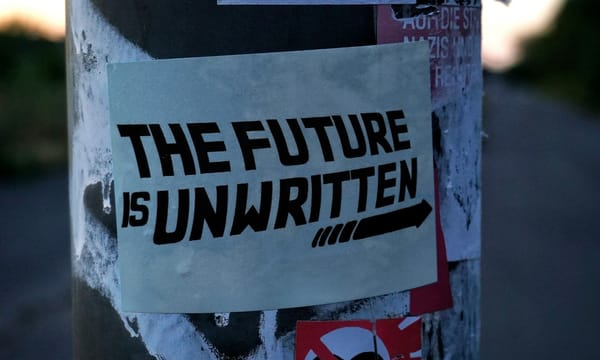Global Solidarity Case Studies & the Transnational Rejection of U.S. Empire
From Gaza to Lagos, from Paris to Santiago, a new transnational movement is emerging—not just resisting authoritarianism at home, but rejecting the systems of U.S.-led imperial dominance globally. Let’s check out what that movement looks like. [Part III]

The myth of American moral leadership is dead. Across the Global South, and increasingly among Gen Z and millennial activists worldwide, the U.S. is no longer seen as a symbol of freedom. It is recognized, accurately, as an empire built on surveillance, extraction, militarized policing, and settler violence.
And globally? People are done pretending.
From Gaza to Lagos, from Paris to Santiago, a new transnational movement is emerging—not just resisting authoritarianism at home, but rejecting the systems of U.S.-led imperial dominance globally.
Let’s check out what that movement looks like.
1. Global South Solidarity with Palestinians
The brutal siege of Gaza and decades of occupation have become a rallying point not only for Arab nations, but for people across Africa, Latin America, and Southeast Asia.
- Protests have erupted in Kenya, Chile, and Indonesia—not just against Israel, but against their own governments’ ties to U.S.-funded militarism.
- Activists frame Palestine as “the testing ground of empire”—where weapons, surveillance, and psychological warfare are perfected before being deployed elsewhere.
- In turn, Palestinian organizers have built global networks of mutual aid, cultural resistance, and encrypted comms to teach others how to survive under siege.
Palestine is not a foreign struggle—it is the blueprint of every occupation.
2. The #NoMore Movement – Pan-African Defiance
In Ethiopia, Eritrea, and surrounding nations, people rose up in 2021–2023 with a unified message: #NoMore U.S. intervention, destabilization, and narrative manipulation.
- The movement rejected U.S. “peacekeeping” missions and IMF weaponization of aid.
- Protesters called out color revolutions engineered for extractive trade access.
- African diasporas in the U.S. echoed the chant, connecting struggles from Minneapolis to Mogadishu.
This is anti-colonial and post-imperial clarity.
3. Youth Uprisings – France, Chile, Nigeria
All three nations saw massive youth-led revolts—triggered by police violence, economic betrayal, and corruption, but powered by generational refusal to submit.
- Nigeria’s #EndSARS movement built decentralized protest cells and leveraged music, art, and encrypted apps to dodge state crackdowns.
- France’s banlieue uprisings challenged both Macron’s authoritarian pivot and the racist surveillance state gripping Paris.
- Chile’s 2019 uprising started with a metro fare hike and exploded into a constitutional overhaul—led by students, feminists, and Indigenous organizers.
Each rebellion taught the same lesson: The systems are global. So is the resistance.
4. Gen Z and Millennial Rejection of U.S. Imperial Myths
Younger generations aren’t buying Cold War-era bullshit.
They see:
- Climate catastrophe funded by oil lobbies and defended by the Pentagon
- Police militarization tied to IDF training and DHS expansion
- Corporate consolidation justified by “freedom” rhetoric but enforced through surveillance capitalism
They connect the dots:
- ICE raids to Gaza drone strikes
- Fossil fuel lobbying to Niger military coups
- “Free speech” disinfo campaigns to authoritarian lawfare
This generation doesn’t want to reform the empire. It wants to bury it and build something better.
5. Transnational Mutual Aid & Knowledge Exchange
Quietly, under the radar, radical organizers around the world are:
- Translating security guides and resistance manuals across languages
- Swapping burner phone tactics, off-grid comms blueprints, and protest gear tips
- Hosting encrypted cross-border trainings for Indigenous land defenders, queer anarchists, and student radicals
This is the Rebel Alliance as a global network. Decentralized. Resilient. Unapologetically revolutionary.
So if you’ve ever wondered if anyone out there sees what you see—they do. They’ve lived it, fought it and they’re ready to fight alongside you.
The age of American exceptionalism is over. The age of global anti-authoritarian solidarity is just getting started.
When to Stay Quiet vs. When to Go Loud
Every authoritarian regime weaponizes timing.
They move slowly enough to avoid mass panic, fast enough to disorient, and brutally enough to crush dissent before it can scale.
So the most dangerous thing a resistance can do is misread the moment.
This section is about recognizing the terrain, understanding when to build quietly, and knowing exactly when to escalate—before it’s too late.
Build Quiet When:
- Surveillance is tightening, but mass arrests haven’t started
- Propaganda is dominant, but cracks are visible
- The public is numb, not mobilized
- Local collaborators still outnumber defectors
You’re establishing trust, tools, and infrastructure.
Quiet resistance means:
- Organizing in cells
- Training underground
- Stockpiling off-grid
- Testing systems without drawing fire
- Mapping out pressure points in the regime before striking
This is the “planting seeds” phase. What you grow here decides whether the movement lives when the storm hits.
Go Loud When:
- Repression escalates publicly—bans, disappearances, visible brutality
- A flashpoint breaks denial (a political assassination, blackout, failed election, high profile arrest)
- People who were passive start asking questions or looking for direction
- International attention is momentarily focused
- Your internal infrastructure is stable enough to absorb retaliation
Going loud doesn’t mean reckless violence. It means public refusal. Strategic escalation. Action that forces the regime to reveal itself while demonstrating that the people are not broken.
Examples:
- Coordinated mass walkouts or city-wide shutdowns
- Strategic infrastructure blockades
- Flash-disruption protests that redirect police resources
- Mass digital leak dumps (when secure)
- Anonymous publication of counter-narratives
- Cultural sabotage (projected messages, art bombs, subvertising)
The goal is not chaos. The goal is to collapse the illusion of control.
The Danger of Acting Too Soon
- Burnout, surveillance, and arrests without impact
- Losing trust of the public who hasn’t caught up yet
- Forcing people to choose sides before they’ve emotionally detached from the regime
You don’t light the match when the wood’s still wet.
You wait until the air is dry, the people are angry, and the machine is already starting to shake.
The Danger of Waiting Too Long
- Infrastructure is seized before you’ve gone mobile
- Leaders and organizers are arrested quietly, one by one
- The regime controls the narrative while the resistance is still whispering • Protest becomes a death sentence, not a spark
History is full of people who said “it’s not time yet” until there was no time left. The people who win are the ones who time their refusal with strategic force.
So How Do You Know When It’s Time?
Ask:
- Is silence becoming collaboration?
- Are people finally feeling what you’ve been seeing?
- Are you and your crew ready for the consequences?
And most of all: Will waiting any longer make the risk of acting higher?
When the answer is yes: You go. You go smart. You go together.
You go knowing that history doesn’t reward the cautious. It remembers the ones who refused to wait for permission.
Sources
Section VI: Global Solidarity Case Studies & the Transnational Rejection of U.S. Empire
- Al Jazeera. (2023, October 28). Israel’s war on Gaza: List of key events, day 21. https://www.aljazeera.com/news/2023/10/28/israels-war-on-gaza-list-of-key-events-day-21
- Mahmood, S. (2021). NoMore: How a Pan-African movement took shape to reject U.S. imperialism. African Arguments. https://africanarguments.org/2021/12/nomore-a-pan-african movement-against-imperialism/
- End SARS. (2020). #EndSARS protest timeline and demands. Retrieved from https://www.endsars.com
- International Crisis Group. (2021). Ethiopia’s Tigray War: A Deadly, Dangerous Stalemate. https://www.crisisgroup.org/africa/horn-africa/ethiopia/b173-ethiopias-tigray-war deadly-dangerous-stalemate
Section VII: When to Stay Quiet vs. When to Go Loud
This section draws primarily on:
- Case comparisons and frameworks from earlier sections
- Contemporary protest strategy literature and movement timing theory



